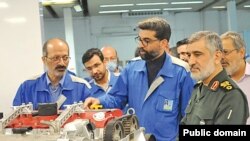The Chief-Commander of the Islamic Revolution Guards Corps' (IRGC) Aerospace Force, Brigadier General Amir Ali Hajizadeh, said on Tuesday, June 9, that the IRGC will transfer its research experiences to the automotive industry.
In January 2018, Iran’s Supreme Leader Ali Khmenei had ordered the IRGC to reduce its role in the country’s economy. Similar pronouncements were also made in 2019. The IRGC has a sprawling economic empire in Iran, controlling or having a stake in more than half of all businesses by some accounts.
At the end of the meeting with the caretaker of the Iranian Ministry of Industry, Mines and Trade (MIMT) and managing directors of the local automotive industry on Tuesday, Hajizadeh maintained that the IRGC's aim is to transfer its knowhow and experience in research activities to Iran's auto-making industry.
The caretaker of MIMT, Hossein Modarres Khiabani, for his part said at the end of the meeting that the IRGC's automotive industry-related technology and facilities in the field of missiles would be used in the local auto manufacturing.
While referring to the Islamic Republic Supreme Leader's (Ayatollah Ali Khamenei) recent comments on defense and auto-making industries, Hajizadeh insisted that such remarks make the IRGC duty-bound to act.
On May 6, Ayatollah Khamenei had stated, "The mind and thought that can produce a satellite" can also produce a "vehicle using five liters (about 1.3 US gallons) of gasoline per hundred kilometers (approximately 62 miles)."
Iran’s auto industry, already suffering from outdated technology, mismanagement and corruption, has been crippled by U.S. sanctions that have stopped collaboration with French and other automakers. The car makers owe government banks billion of dollars.
The IRGC so far has not had any activity in the field of manufacturing vehicles. In recent years, however, there have been suggestions for the elite military to step in the automotive industry.
Manouchehr Manteghi, the former CEO of Iran Khodro Company, the largest Iranian auto manufacturer, proposed in October 2009 that the shares of auto-makers SAIPA and Iran Khodro companies be transferred to the Sepah IRGC Cooperative Foundation.
Hajizadeh also said in October last year: "Given the [poor] quality of domestic cars, many people expect the IRGC to enter the industry and build quality vehicles."
"We (IRGC) own technological industries and are ready to transfer it to the automotive industry of the country. Relying on Iranian technical know-how and knowledge, we can manage the most complicated and sophisticated technologies," Hajizadeh maintained on the sidelines of his visit to Iran Khodro Industrial Group [IKCO] on Friday, May 29.
The IRGC's plans and inclination to enter the automotive industry comes at a time when there have been reports of the military forces withdrawing from the country's economic sector.
On January 20, 2018, Iran’s Defense Minister, Amir Hatami, said that Khamenei had ordered the country’s powerful IRGC to curtail its growing business empire and divest its commercial assets that are not relevant to its domain of work.
Furthermore, on May 19 a parliamentary investigation revealed that the involvement of the country's fearsome intelligence organs in Iran Khodro and SAIPA had increased corruption in the corporations, turning them into loss-making companies.
Therefore, it is not yet known why the parliament's warnings have been ignored, and the IRGC is set to dominate the country's auto industry, as well.
Based on the International Organization of Motor Vehicle Manufacturers' data, Iran's annual car production in 2019 decreased by 25% compared with the previous year, dropping to 821,000 units, of which 770,000 units were sedans.
Despite the sharp decline in car production in Iran, the car market, valued at $ 12 billion to $ 15 billion a year, is still one of the country's most important and attractive sectors.






